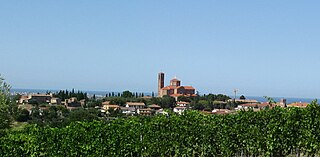
Rimini is a city in the Emilia-Romagna region of northern Italy and capital city of the Province of Rimini. It sprawls along the Adriatic Sea, on the coast between the rivers Marecchia and Ausa. It is one of the most notable seaside resorts in Europe with revenue from both internal and international tourism forming a significant portion of the city's economy. It is also near San Marino, a small nation within Italy. The first bathing establishment opened in 1843. Rimini is an art city with ancient Roman and Renaissance monuments, and is also the birthplace of the film director Federico Fellini.

Piero della Francesca was an Italian painter of the Early Renaissance. To contemporaries he was also known as a mathematician and geometer. Nowadays Piero della Francesca is chiefly appreciated for his art. His painting is characterized by its serene humanism, its use of geometric forms and perspective. His most famous work is the cycle of frescoes The History of the True Cross in the church of San Francesco in the Tuscan town of Arezzo.

Federico da Montefeltro, also known as Federico III da Montefeltro KG, was one of the most successful mercenary captains (condottieri) of the Italian Renaissance, and lord of Urbino from 1444 until his death. A renowned intellectual humanist and civil leader in Urbino on top of his impeccable reputation for martial skill and honor, he commissioned the construction of a great library, perhaps the largest of Italy after the Vatican, with his own team of scribes in his scriptorium, and assembled around him a large humanistic court in the Ducal Palace, Urbino, designed by Luciano Laurana and Francesco di Giorgio Martini.

Fano[ˈfaːno] is a town and comune of the province of Pesaro and Urbino in the Marche region of Italy. It is a beach resort 12 kilometres southeast of Pesaro, located where the Via Flaminia reaches the Adriatic Sea. It is the third city in the region by population after Ancona and Pesaro.

Sigismondo Pandolfo Malatesta was an Italian condottiero and nobleman, a member of the House of Malatesta and lord of Rimini and Fano from 1432. He was widely considered by his contemporaries as one of the most daring military leaders in Italy and commanded the Venetian forces in the 1465 campaign against the Ottoman Empire. He was also a poet and patron of the arts.
Massimo Tamburini was an Italian motorcycle designer for Cagiva, Ducati, and MV Agusta, and one of the founders of Bimota. Tamburini's designs are iconic in their field, with one critic calling him the "Michelangelo of motorbike design". His Ducati 916 and MV Agusta F4 were included in the Guggenheim Museum's The Art of the Motorcycle exhibit of 1998–1999.

The House of Malatesta was an Italian family that ruled over Rimini from 1295 until 1500, as well as other lands and towns in Romagna and holding high positions in the government of cities in present day Tuscany, Lombardy and Marche. The dynasty is considered among the most important and influential of the Late Middle Ages. In the period of maximum influence, they extended their domains along the Marche coast, up to Ascoli Piceno, Senigallia, Sansepolcro and Citerna, and to the north, on the territories of Bergamo and Brescia.

Agostino di Duccio was an early Renaissance Italian sculptor.

Coriano is a comune in the province of Rimini. This town is known for being the city of the Motorcycle World Champion, in 250cc class, Marco Simoncelli.

Santarcangelo di Romagna is a town and comune in the province of Rimini, Emilia-Romagna, Italy, on the Via Emilia. As of 2009, it had a population of some 21,300. It is crossed by two rivers, the Uso and the Marecchia.

Roberto Malatesta was an Italian condottiero, or mercenary captain, lord of Rimini, and a member of the House of Malatesta.

The Tempio Malatestiano is the unfinished cathedral church of Rimini, Italy. Officially named for St. Francis, it takes the popular name from Sigismondo Pandolfo Malatesta, who commissioned its reconstruction by the famous Renaissance theorist and architect Leon Battista Alberti around 1450.

The Portrait of Sigismondo Pandolfo Malatesta is a painting attributed to the Italian Renaissance master Piero della Francesca. It portrays the condottiero and lord of Rimini and Fano Sigismondo Pandolfo Malatesta, and is housed in the Musée du Louvre of Paris.
The decade of the 1450s in art involved many significant events, especially in sculpture.
The decade of the 1420s in art involved some significant events.

Isotta degli Atti was an Italian Renaissance woman and regent. She was the mistress and later wife of the condottiero and lord of Rimini, Sigismondo Pandolfo Malatesta. She governed Rimini as regent during the excommunication of Malatesta in 1460-62, as well as during the minority of their son in 1468–69.

Ginevra d'Este was an Italian noblewoman. She and her twin sister Lucia were daughters of Niccolò III d'Este and his second wife Parisina Malatesta - they also had a younger brother, who died aged a few months. She was the first of Sigismondo Pandolfo Malatesta's three wives.
The following is a timeline of the history of the city of Rimini in the Emilia-Romagna region of Italy.

Teodoro Francesco Maria Gasparo Correr was a Venetian abbot and art collector, most notable as the founder of the Museo Correr.

Sallustio Malatesta was an Italian noble. He was the son of Sigismondo Pandolfo Malatesta, lord of Rimini, and Isotta degli Atti. At first, Isotta was Sigismondo's mistress, but after the death of his wife Polissena Sforza, they would marry.














